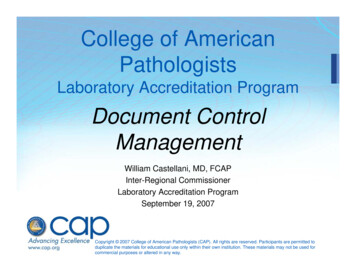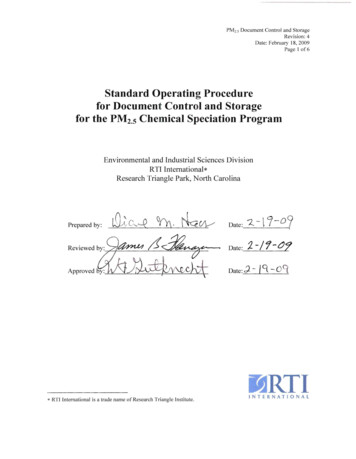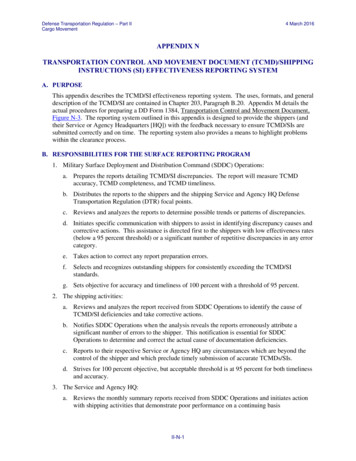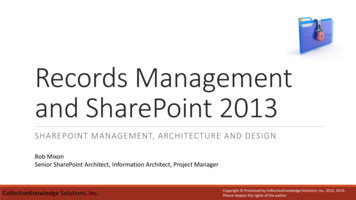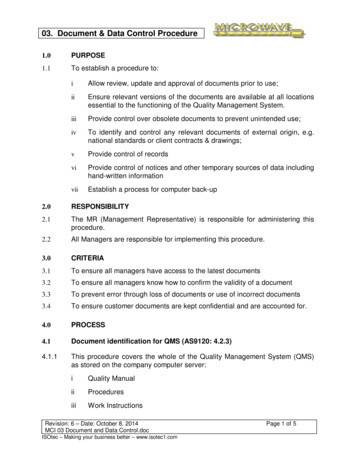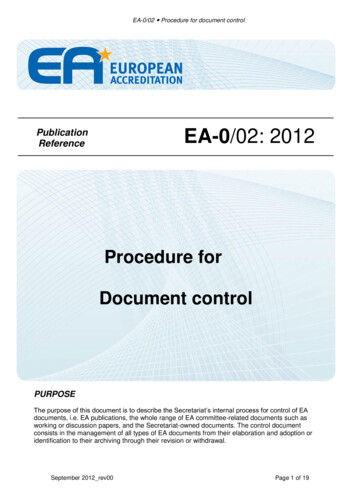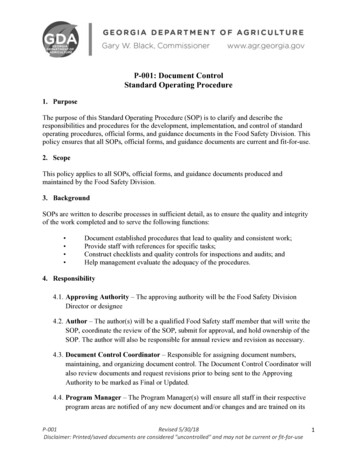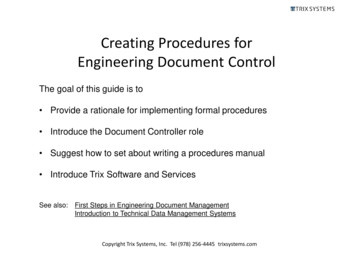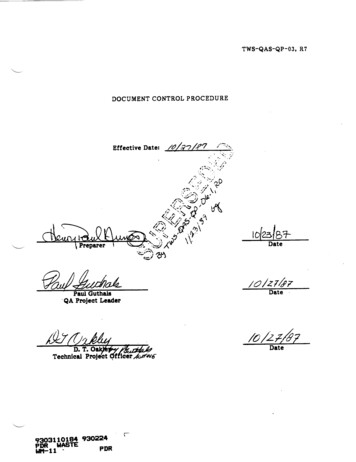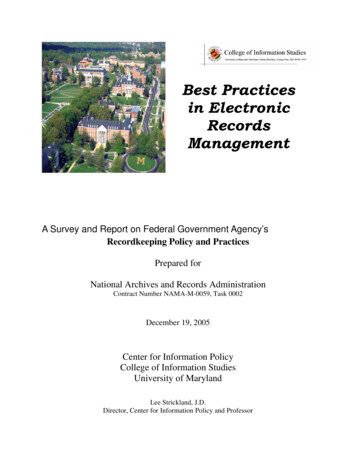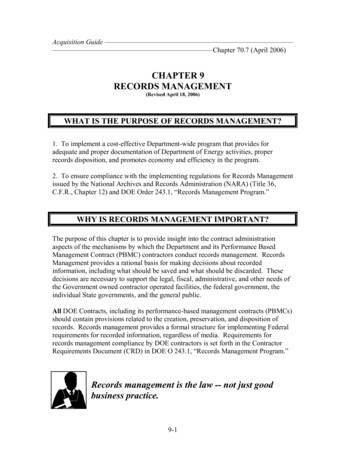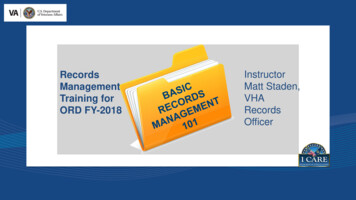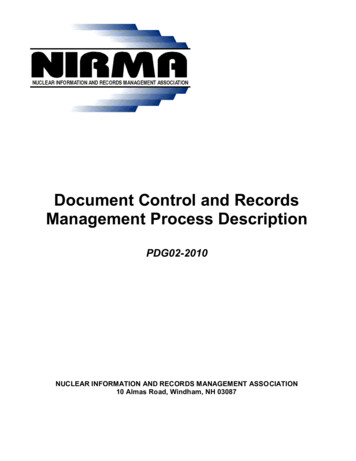
Transcription
Document Control and RecordsManagement Process DescriptionPDG02-2010NUCLEAR INFORMATION AND RECORDS MANAGEMENT ASSOCIATION10 Almas Road, Windham, NH 03087
Process descriptions developed by a committee, subcommittee, or ad hoc committee of the NuclearInformation and Records Management Association (NIRMA) represent a consensus of the members ofthe committee, subcommittee, or ad hoc committee with the concurrence of the NIRMA membership andBoard of Directors. These guidelines are recommended for establishing a program or performance of atask related to the interests of NIRMA members. Process descriptions represent the consensus of thesponsoring committee on the best information based upon applicable regulatory requirements, industrystandards and practical experience. A lesser amount of detail may be used to identify the areas ofinterface outside the scope of the document. Process descriptions are not intended to be interpreted asindustry standards but as suggested guidance with the understanding that companies are not obligated touse the suggested guidance.NOTICEThis document was prepared by a committee of the Nuclear Information and Records ManagementAssociation (NIRMA). Neither this committee, members of NIRMA, other persons contributing to orassisting in the preparation of the document, nor any person acting on behalf of these parties (a) makesany warranty or representation, expressed or implied, with respect to the accuracy, completeness, orusefulness of the information contained in this document, or (b) that the use of any information,apparatus, method, or process disclosed in this document may not infringe on privately owned rights, or(c) assumes liabilities with respect to the use of any information, apparatus, method, or process disclosedin this document. 2010. Nuclear Information and Records Management Association. All rights reserved.
FOREWORDIn March 2009, an industry task force was chartered to develop an industry process description fordocument control and records management. The task force convened under the direction of the NuclearInformation Management Strategic Leadership (NIMSL) steering committee, a Community of Practice(CoP). NIMSL is a committee of NIRMA. This task force was composed of representatives from theNIMSL CoP and subject-matter experts from document control and records management in the industry.This document describes processes nuclear facilities use to meet the requirements of 10 CFR 50Appendix B Criteria VI and XVII, addressing document control and records management, respectively.This process description was compiled based on industry consensus on a standard process for documentmanagement. The document management process consists of document creation, document control andrecords management. This process description addresses aspects of all three subprocesses, but isprimarily focused on document control and records management.Many guidance documents have addressed aspects of the records management process. However,these have not provided the same level of information about the document control process. This processdescription provides such detail and also addresses the coordination with the records managementprocess.Because new technologies provide electronic access to existing material and electronic processing ofnew material, the document management processes have undergone extensive evolution. This processdescription addresses principles in the document management process. For special concepts regardingthe electronic management of documents, see Nuclear Information & Records Management Association(NIRMA) Technical Guideline TG15, ―Management of Electronic Records.‖The structure of an organization may dictate how these processes are organized within a company. Thisdocument is a process description and does not imply how a company may be organized to implementthe process. Some organizational variances are as follows:centralized versus decentralizedvarious combinations of document control, records management, and procedure controlfunctions performed by originating groups instead of control groupscombinations of nuclear records and corporate recordsWhatever approach is taken, the role in developing an integrated software approach fordocument/records management cannot be underestimated. Often, selection of a software tool will have amajor impact on how information management is organized.Appendix A defines the terms used in this document.A selection of both industrywide and diagnostic performance measures is provided in Appendix D.Industrywide performance measures are used for process performance comparison and as comparativeanalytical tools (plant to plant). Diagnostic measures are intended to be used as analytical tools byprocess owners when measuring the health of the process (internal use) and when performing selfassessments of the information management processes.The PDG series of documents is for process description guidelines. Each process description guidelinereflects the integration of experience gained from operating plants to processes under development forthe operation of future standard plants. The "AP" annotation originally stood for "advanced plant";however, the reference has come to refer to "advanced process." Information management is anenabling process as described in PDG01, Information Management Process Description Guideline, andthe Standard Nuclear Performance Model. Appendix I provides a history of the AP-907 series ofdocuments, which are now the PDG series of NIRMA documents.i
ACKNOWLEDGEMENTSThe NIRMA thanks the following utilities and industry organizations for providing the personnel andresources necessary to perform this project:Constellation EnergyExelon NuclearFirstEnergy CorporationNuclear Information Management Strategic Leadership (NIMSL)Ontario Power GenerationSTP Nuclear Operating CompanyOrganizations that participated in the developmental review process are as follows:Bruce PowerDominionPSEG NuclearTennessee Valley AuthorityAppendix B lists task force members and reviewers.Appendix E provides a list of references used in the development of this process description.ii
TABLE OF CONTENTSTitlePageForeword. iAcknowledgements .ii1.0Purpose . 12.0Application . 42.1 Types of Documents and Records . 43.02.2Process Elements. 52.3Application Guidance . 6Process Description Flowcharts . 63.1 Context Flowchart – Level 0, Document Control and Records Management . 73.2Top-Level Flowchart – Level I, Document Control and Records Mgmt . 83.3Flowchart – Level II, OR - Originator . 93.4Flowchart – Level II, DC - Document Control. 103.5Flowchart – Level II, RM - Records Management . 113.6Flowchart Text Descriptions – Level III . 12Appendix AAppendix BAppendix CAppendix DAppendix EAppendix FAppendix GAppendix HAppendix IGlossary of Terms and Definitions. A-1Task Force List . B-1Process Modeling and Flowchart Conventions . C-1Performance Measures. D-1Reference List . E-1Documents in Document Management System . F-1Standards and Transformation. G-1Document Statuses . H-1Revision History . I-1TABLE OF FIGURESFigure 1 All Documents Venn Diagram . 2Figure 2 Standard Nuclear Performance Model (SNPM) Process Architecture . 3.iii
1.0PURPOSEThis process description provides a standard process for document control and records management.Document control and records management are addressed in 10 CFR 50 Appendix B as follows:VI.Document ControlMeasures shall be established to control the issuance of documents, such asinstructions, procedures, and drawings, including changes thereto, which prescribe allactivities affecting quality. These measures shall assure that documents, includingchanges, are reviewed for adequacy and approved for release by authorized personneland are distributed to and used at the location where the prescribed activity is performed.Changes to documents shall be reviewed and approved by the same organizations thatperformed the original review and approval unless the applicant designates anotherresponsible organization.XVII.Quality Assurance RecordsSufficient records shall be maintained to furnish evidence of activities affecting quality.The records shall include at least the following: Operating logs and the results of reviews,inspections, tests, audits, monitoring of work performance, and materials analyses. Therecords shall also include closely-related data such as qualifications of personnel,procedures, and equipment. Inspection and test records shall, as a minimum, identify theinspector or data recorder, the type of observation, the results, the acceptability, and theaction taken in connection with any deficiencies noted. Records shall be identifiable andretrievable. Consistent with applicable regulatory requirements, the applicant shallestablish requirements concerning record retention, such as duration, location, andassigned responsibility.Briefly stated:Document control is the process used to maintain documents that control the design,operation, maintenance, and configuration of the site.Records management is the process for providing evidence of those activities.The utility quality assurance program will rely on N45.2.9/NQA-1 for records, but similar detailed guidancespecifically related to document control is not found in the ANSI N45.2 standards. Document control isemphasized in the configuration management activities of INPO. Other 10 CFR 50 Appendix B criteriaare dependent on the above criteria, especially III, IV, and V.The following Venn diagram shows the relationships among documents.1
non-quality documentsdocument rdsFigure 1All Documents Venn DiagramDocument control and records management are two separate processes. With the use of currentsoftware, these processes have become more closely intertwined. However, even in an integratedpackage these are still distinct functions.PDG02 is intended to be used to establish the proper process for document creation, control, andmanagement as records. This is one of the subprocesses that make up Information Management aspresented in PDG01.The SS003 subprocess is defined by the Standard Nuclear Performance Model. Figure 2 shows thesubprocess model architecture.2
Process HierarchyEUCGCodeLevel 09 ProcessesEUCGCodeLevel 146 SubprocessesActivity levelLevels 2 and3 areCompanySpecificTaskElectricity ProductionLevel 2Level 3Operate PlantOP01 OperationsOP02 EnvironmentalOP03 ChemistryOP04 Radiation ProtectionOP05 RadwasteDesignEngineering /ConfigurationManagementCM01CM02CM03CM04Evaluate Problem or Desired ChangeChange Design RequirementsChange Physical ConfigurationChange Facility Configuration InformationWork ManagementWM01 Planning & SchedulingWM02A Preventive MaintenanceWM02B Maintenance Surveillance TestingWM02C Corrective MaintenanceWM02D Tool Room & CalibrationWM02E Non-Capital Plant ImprovementsWM02F Fix-It-Now Teams (Dedicated)Plant Engineering /EquipmentReliabilityER01 Long Term Planning & Life Cycle ManagementER02 Performance MonitoringER03 Continuous Equipment Reliability ImprovementMaterials &ServicesMS01 Materials Management &WarehousingMS02 Contracts & PurchasingMS03 Procurement EngineeringMS04 Unneeded Material DisposalSupport ServicesSS01 Information TechnologySS02 Business ServicesSS03 Records Management and ProceduresSS04 Human ResourcesSS05 Housekeeping / Facilities ManagementSS06 Communications / Community RelationsSS07 Mgmt. Assistance / Industry AssociationsSS08 Nuclear Officers and ExecutivesSS09 Employee Incentive ProgramSS10 InsuranceSS11 Payroll Taxes, Pension & BenefitsFigure 2LossPreventionTrainingLP01 SecurityLP02 Quality AssuranceLP03 Quality ControlLP04 Corrective Action Program & OELP05 Safety / HealthLP06 LicensingLP07 Emergenc
management. The document management process consists of document creation, document control and records management. This process description addresses aspects of all three subprocesses, but is primarily focused on document control and records management. Many guidance documents have addressed aspects of the records management process. However,File Size: 710KBPage Count: 40
